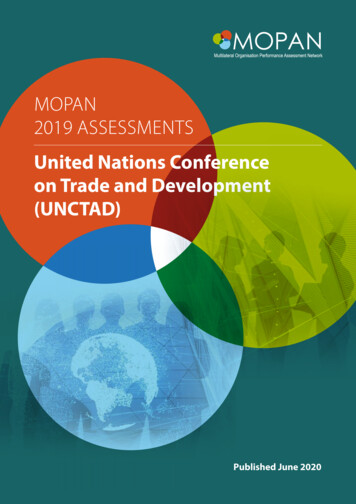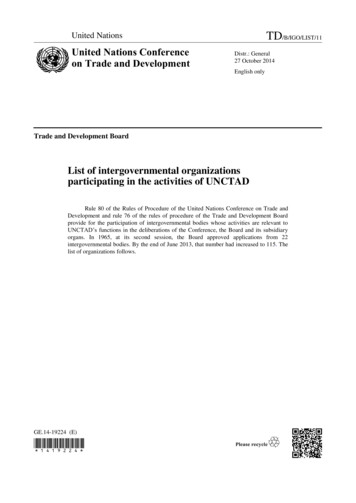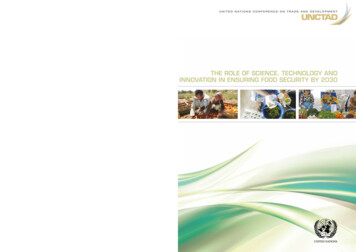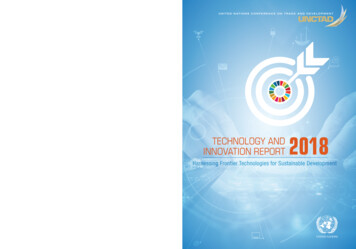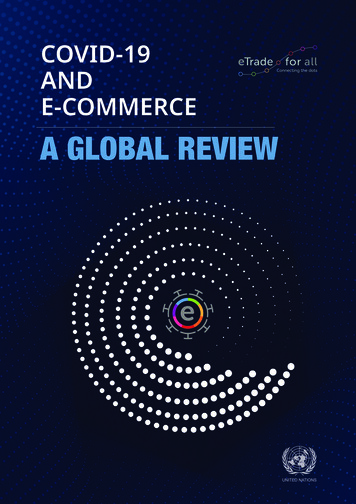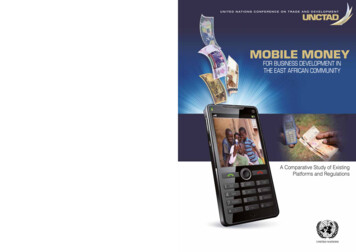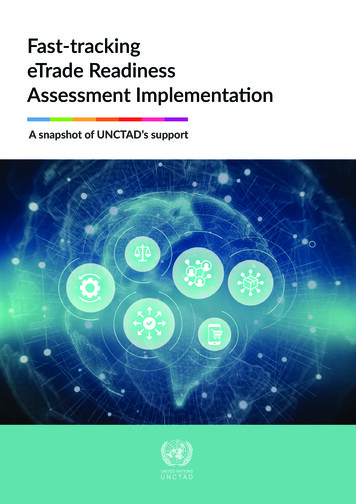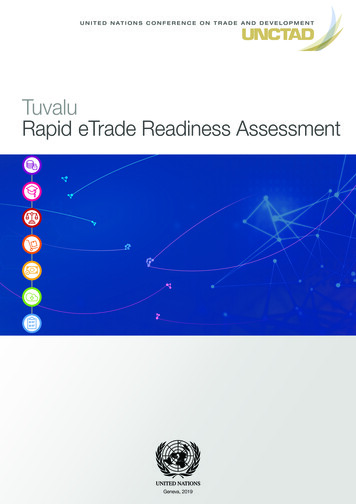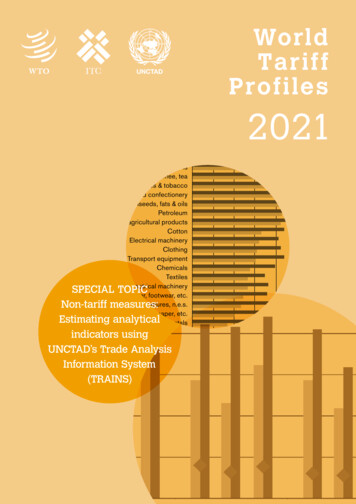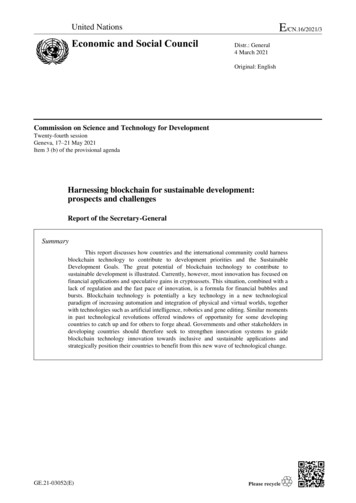
Transcription
E/CN.16/2021/3United NationsEconomic and Social CouncilDistr.: General4 March 2021Original: EnglishCommission on Science and Technology for DevelopmentTwenty-fourth sessionGeneva, 17–21 May 2021Item 3 (b) of the provisional agendaHarnessing blockchain for sustainable development:prospects and challengesReport of the Secretary-GeneralSummaryThis report discusses how countries and the international community could harnessblockchain technology to contribute to development priorities and the SustainableDevelopment Goals. The great potential of blockchain technology to contribute tosustainable development is illustrated. Currently, however, most innovation has focused onfinancial applications and speculative gains in cryptoassets. This situation, combined with alack of regulation and the fast pace of innovation, is a formula for financial bubbles andbursts. Blockchain technology is potentially a key technology in a new technologicalparadigm of increasing automation and integration of physical and virtual worlds, togetherwith technologies such as artificial intelligence, robotics and gene editing. Similar momentsin past technological revolutions offered windows of opportunity for some developingcountries to catch up and for others to forge ahead. Governments and other stakeholders indeveloping countries should therefore seek to strengthen innovation systems to guideblockchain technology innovation towards inclusive and sustainable applications andstrategically position their countries to benefit from this new wave of technological change.GE.21-03052(E)
E/CN.16/2021/3Introduction1.At its twenty-third session, in May 2020, the Commission on Science andTechnology for Development of the United Nations selected “Harnessing blockchain forsustainable development: prospects and challenges” as one of its priority themes for the2020–2021 intersessional period.2.In an increasingly digitalized economy and society, security and accountability inrelation to data transactions are critical for creating trust and enabling breakthroughinnovations in the digital world. In this regard, blockchain technology could be a gamechanger, with the potential to revolutionize processes from finance to pharmaceuticalindustries, from government public services to humanitarian work and development aid.Blockchain technology serves as the base technology for cryptocurrencies, enabling open(peer-to-peer), secure and fast transactions. The application of blockchain technology hasexpanded to include various financial transactions (e.g., online payments and exchangeplatforms), the Internet of things, health systems and supply chains.3.However, issues associated with scalability, privacy concerns, uncertain regulatorystandards and difficulties posed by the integration of technology into existing applicationsare some of the potential market constraints. There is also a risk that the potential ofblockchain technology for solving developmental problems has been inflated by its earlyadopters and media writing about technology, and that it may not be as applicable fordeveloping and least developed countries.4.The secretariat of the Commission on Science and Technology for Developmentconvened an intersessional panel from 17 to 22 January 2021 to better understand thistheme and assist the Commission in deliberations at its twenty-fourth session. This report isbased on the issues paper prepared by the Commission secretariat, the findings andrecommendations of the intersessional panel, country case studies contributed by MemberStates of the Commission, relevant literature and other sources. 1I. Blockchain technology5.Blockchain technology was invented to create bitcoin and serves as the basetechnology for other cryptocurrencies, enabling secure and peer-to-peer transactionsrecorded in a distributed ledger (i.e. electronically distributed registers of transactions). 2Blockchain technology implements a secure distributed ledger through a combination ofblocks of data, cryptography and an algorithm for the network nodes to “reach consensus”on transactions (see figure).6.While the bitcoin network only records cryptocurrency transactions, secondgeneration blockchain technologies, such as Ethereum, 3 expand use of blockchaintechnology by recording “smart contracts”4 in the ledger, which are executed automaticallywhen the conditions of the contract are met. The latest advances are led by consortiums of12342The issues paper and contributions cited in this report are available at sional-panel. Contributions from the Governments of Austria, Belgium, Cuba,Finland, the Islamic Republic of Iran, Kenya, Latvia, Portugal, Romania, the Russian Federation,Saudi Arabia, Switzerland, Thailand, Turkey and the United Kingdom of Great Britain and NorthernIreland, as well as from the Economic Commission for Europe, Economic and Social Commission forAsia and the Pacific, Economic and Social Commission for Western Asia, Food and AgricultureOrganization of the United Nations, International Trade Centre, International TelecommunicationUnion, United Nations Industrial Development Organization, World Food Programme and WorldIntellectual Property Organization, are gratefully acknowledged.Nakamoto S, 2008, Bitcoin: a peer-to-peer electronic cash system. White paper, available .org/en/.Contracts implemented by computer code that are executed automatically in the blockchain when theconditions are met.
E/CN.16/2021/3firms and other stakeholders, such as Hyperledger, Enterprise Ethereum Alliance and R3, toaddress shortcomings of previous implementations of blockchain technology, such asperformance, scalability and interoperability.How blockchain technology worksSource: UNCTAD, based on United Nations Innovation Network (2019). A practical guide to using blockchainwithin the United Nations, available at https://atrium.network/guide.A.Applications and trends7.According to some estimates, the market for blockchain technology solutions andapplications was approximately 708 million in 2017; it is expected to exceed 60 billion in2024.5 Blockchain technology can be used in essentially any application. Currently, theprominent uses are in online payments, finance, international trade and global value chains.1.Cryptocurrencies, tokens and online payments8.The first use of and best-known blockchain technology application is for buildingcryptocurrencies and online payment systems with rapid, low-cost and secure transactionsand no intermediaries. In addition to cryptocurrencies such as bitcoin, libra and monero,cryptocurrencies also include protocol tokens (e.g., ether), utility tokens, securities tokens(e.g., cryptoequities and cryptobonds), natural asset tokens, cryptofiat currencies andstablecoins.9.In October 2020, there were more than 1,000 cryptocurrencies. Many still have anegligible market capitalization. Only 46 cryptocurrencies had a market capitalizationhigher than 100 million, and 17 cryptocurrencies had a market capitalization higher than 1 billion. The total capitalization of the 100 most valued cryptocurrencies was 330 billion, of which bitcoin accounted for 200 billion.610.The number of bitcoin transactions per day was more than 300,000 in October2020; 7 25 million bitcoin (electronic) addresses held bitcoins by the end of 2018. 8By comparison, the credit card company Visa handles over 5.6 trillion transactions per day,and there were 3.3 billion Visa cards worldwide in edia/visanettechnology/aboutvisafactsheet.pdf.3
E/CN.16/2021/32.Decentralized finance11.Decentralized finance is an area of rapid innovation. It refers to financial instrumentsbased on blockchain technology implemented through smart contracts. In November 2020,there were 251 decentralized finance projects listed in DeFiprime.com, a media outlet forthe decentralized finance community. The market capitalization of the top 100decentralized finance tokens was 12.7 billion, and the market value of the top 10decentralized finance tokens was 9.1 billion, or 71 per cent of the total. 1012.Users have demonstrated trust in placing an increasing amount of funds into smartcontracts smart contracts that sustain the decentralized finance ecosystem, suggestinggrowing confidence in these new financial tools. By the end of 2020, there were 11.06 billion invested in decentralized finance projects, with the top 10 projectsrepresenting 94 per cent of the total.113.International trade13.In international trade, use of smart contracts allows for automatic, swift and timelyissuance of customs invoices, permits, licences and certificates generated after fees andduties are paid. This can reduce back-office costs, consignment clearance time and thepotential for corruption.14.Numerous companies and governments are forming alliances to deploy blockchaintechnology in international trade. The Global Shipping Business Network 12 has alreadystarted testing the technology to increase efficiency.13 Tradelens,14 the IBM and Maersk-ledconsortium of leading firms in the shipping and maritime industry, has successfully trialledan electronic bill of lading.15 These efforts are increasing rapidly, with more shipping andmaritime industry leaders collaborating on increasing efficiency.4.Value chains15.Blockchain technology can improve transparency, traceability and reliabilitythroughout global value chains. Several successful proof-of-concept implementationssuggest that blockchain technology will likely lead to disruptive transformations, rangingfrom cost savings and increased efficiencies to new operational models. Two promisingapplications are the tracking of goods through the production and delivery process, toensure quality and authenticity, and automated compliance with freight and traderegulations. For instance, the Walmart blockchain technology solution which uses IBMHyperledger Fabric has reduced time for tracking the origins of mangoes from seven daysto 2.2 seconds and promoted greater transparency across the Walmart food supply chain. 16B.System of innovation of blockchain technology16.The blockchain system of innovation is more global than for other frontiertechnologies, such as artificial intelligence. Blockchain technology innovations have drawnon programmers from developed and developing countries, currency exchanges in severalmarkets, “cryptomining” (distributed across the world) – in places with low-cost energyresources – and a user base of retail traders and financial institutions from all over delensblockchain-platform/.Kamath R, 2018, Food traceability on blockchain: Walmart’s pork and mango pilots with IBM, TheJournal of British Blockchain Association 1(1):1–12.
E/CN.16/2021/3world.17 The fact that blockchain technology innovation has been directed mainly towardsfinancial and payment solutions further contributes to the globalization of the system ofinnovation of blockchain technology.17.A key feature of this system is that many of the blockchain technology initiativesinvolve open-source, free and readily available software. Many of them are funded orsupported by not-for-profit foundations (e.g. Bitcoin Foundation, Ethereum Foundation, theLibra Foundation and the Blockchain Charity Foundation).18.Multinational companies operating in traditional sectors have also entered this sectorwith different initiatives. 18 Given their international operations, these companies alsocontribute to global innovation and deployment of blockchain technology applications.19.New non-governmental organizations and research institutes specializing inblockchain technology are being established; an example is the Blockchain ResearchInstitute,19 a think tank funded by international corporations and government agencies. Thiscould become a leading trend in integrating the technology into the work ofnon-governmental organizations and increasing efficiency in the non-profit sector.20.An increasing number of universities have designed courses specifically to studyblockchain. Several blockchain technology companies are collaborating with academicinstitutions on research and development and product design.20 It is expected that a newecosystem will emerge with academics, advisers, programmers, financial analysts andcryptoeconomists at its core.C.Financing blockchain technology innovation21.A particularity in the blockchain technology ecosystem is the significant use ofcrowdfunding to finance innovations. Initial coin offerings and other innovative forms ofdistributed finance allow for fast ways to raise money for blockchain technology innovation(and for emergence of bubbles). This sets blockchain technology innovation apart frominnovation in other technologies that rely more heavily on traditional finance sources(e.g., Venture Capital).22.Through initial coin offerings, a team of developers sells tokens to finance thedevelopment of a solution. Usually, a share of the tokens is distributed to the developmentteam and initial investors. After the bitcoin price bust in 2017, initial coin offerings werescrutinized by regulators in the United States of America, and some of the initial coinofferings were considered to breach securities regulations.2123.More recently, other forms of decentralized finance have taken advantage ofcryptocurrency valuation, such as bitcoin, to finance the development of new applications.II. Potential impact of blockchain technology on theachievement of the Sustainable Development Goals24.As with any technology, blockchain technology can be applied in solutions thatcontribute to the achievement of the Sustainable Development Goals. There are severalexamples of such applications, both in developed and developing countries. Many are stillin the pilot phase or have been deployed but no impact assessment is available.17For example, see Riasanow T et al., 2018, The generic blockchain ecosystem and its strategicimplications, 24th Americas Conference on Information Systems; and Zalan T, 2018, Born global onblockchain. Review of International Business and Strategy, 28(1):19–34.18 Chang Y, Iakovou E and Shi W, 2020, Blockchain in global supply chains and cross border trade: acritical synthesis of the state-of-the-art, challenges and opportunities, International Journal ofProduction Research, 58(7):2082–2099.19 https://www.blockchainresearchinstitute.org/.20 For example, see Wang Y et al., 2019, A review of fast-growing blockchain hubs in Asia, The Journalof The British Blockchain Association, 2(2):83–98.21 https://www.sec.gov/ICO.5
E/CN.16/2021/3 Sustainable Development Goal 1.4 (equal rights to ownership, basic services,technology and economic resources). In Thailand in 2019, the Government initiateda digital identity project to develop a nationwide digital identification platform usingblockchain technology to authenticate and verify the digital identities of Thaicitizens.22 Sustainable Development Goal 2.1 (end hunger and ensure access by all people, inparticular the poor and people in vulnerable situations). The World Food Programmehas created the “Building Blocks” voucher delivery platform to simplify vouchertransactions by removing the need to create virtual custodial accounts with financialservices providers. The initiative benefited 700,000 people in 2020. 23 Sustainable Development Goal 6.4 (increase water use efficiency and ensurefreshwater supplies). In Australia, the Government of the State of New South Walesbuilt a proof-of-concept that uses blockchain technology to make the water tradingsystem more reliable, transparent and efficient to manage.24 Sustainable Development Goal 7.3 (double the improvement in energy efficiency).A Russian power company has implemented a pilot project to use blockchaintechnology for electric power metering to ensure efficiency in the system andtransparency in data exchange between electricity companies and consumers. 25 Sustainable Development Goal 10.3 (ensure equal opportunity). The United NationsChildren’s Fund (UNICEF) Project Connect is a blockchain technology-basedplatform to map every school in the world and each school’s connectivity, whichprovides real-time data on the quality of each school’s Internet connectivity.26 Sustainable Development Goal 17.3 (mobilize financial resources for developingcountries). The United Kingdom launched a blockchain-enabled platform tocoordinate and trace international aid using smart contracts. This solution canimprove the overall speed, cost and transparency of funds across the financial supplychain.2725.In principle, there are no limits to the application of blockchain technology intechnological solutions for the Sustainable Development Goals. A well-designedblockchain technology application can help store information, track value exchange andautomate rules and smart contracts.2826.However, examining the full potential impact of blockchain technology on theachievement of the Sustainable Development Goals requires sufficient information, whichis not available at this stage. Hence, a forward-looking approach is used in the presentdocument to analyse the impact of blockchain technology in the context of differentscenarios. Some potential unintended consequences are also analysed.A.Forward-looking scenarios27.This section focuses on how forward-looking scenarios could play out and theimpact of each scenario on sustainable development. These scenarios are non-mutually22Contribution of Thailand, available at nt/CSTD 2020-21 c30 B Thailand en.pdf.23 Contribution of the World Food Programme, available at nt/CSTD 2020-21 c41 B WFP en.pdf.24 lockchain25 Contribution of the Russian Federation, available at nt/CSTD 2020-21 c25 B Russia en.pdf.26 https://www.projectconnect.world27 Contribution of the United Kingdom of Great Britain and Northern Ireland, available ument/CSTD 2020-21 c34 B UK en.pdf.28 United Nations Innovation Network, 2019, A practical guide to using blockchain within the UnitedNations, available at https://atrium.network/guide.6
E/CN.16/2021/3exclusive and highlight visions that society in general attributes to blockchain technologybased on many facets of applying the technology that are still in the early stages.28.A past example is the Internet. An initial vision that society had about Internettechnology was that it would create a “global village” that would spread equity, justice anddemocracy. These were expectations based on technical characteristics of the Internet(e.g. inexpensive, instantaneous and two-way communication). Still, they did not foreseeunintended consequences, such as the digital divide, misinformation and data privacy andsecurity.29.Currently, blockchain technology is similarly in its infancy. There are manydifferent visions of how it will develop, which products will emerge and the potentialconsequences of their use.1.Scenario: decentralized applications overtake centralized ones30.In this scenario, blockchain technology is seen as a tool to create decentralizedapplications that replace centralized ones (based on centralized databases) for more securityand transparency.31.There is also an expectation of lower transaction costs when using blockchaintechnology solutions. However, there is nothing in the technology that requires transactioncosts to be low. For example, the so-called “gas” (fee) in the Ethereum platform, whichusers pay for miners to register user transactions in a blockchain, reached high levels inSeptember 2020, with some users paying 11 per transaction. 29 It is not clear whetherblockchain technology applications will be systematically more affordable than centralizedones.32.If indeed decentralized applications overtake centralized ones, it could have a severenegative impact on the environment due to the use of “proof-of-work” in the blockchain asa consensus mechanism, which is energy inefficient, as discussed later in this report.33.There are several heuristics proposed to guide the decision between a traditionaldatabase and blockchain technology.30 Usually, the default choice is for central databases,and only when the risk of centralized solutions is considered too high by the users, is ablockchain solution proposed.34.Thus, blockchain could facilitate innovation for the Sustainable Development Goalswhen they enable solutions that otherwise would not exist as centralized applications.However, the roadblocks for implementing technological solutions for the SustainableDevelopment Goals are usually not in the technologies themselves but on the access tothese technologies, including availability, affordability, awareness, accessibility and abilityto use.3135.If blockchain technologies replace centralized ones in technological solutions for theSustainable Development Goals, use of blockchain technologies still requires universalInternet access, digital skills, and laws and regulations related to data privacy and security,as well as reliable and affordable electricity from non-climate change contributing sources.2.Scenario: applications are developed for financial inclusion36.In this scenario, see blockchain technology is seen as a tool that will allow people tohave access to financial services at low costs, banking those connected but unbanked, forexample, by creating blockchain technology versions of mobile digital transfers andmicrocredit services that charge lower fees.37.Mobile digital transfer applications, such as M-Pesa in Kenya, have the advantage ofbeing low cost and easy to use, and operated with mobile applications and a highs/.For example, see United Nations Innovation Network, 2019, A practical guide to using blockchainwithin the United Nations, available at https://atrium.network/guide.UNCTAD, 2021, Technology and Innovation Report 2021: Catching Technological Waves –Innovation with Equity (United Nations publication, Sales No. E.21.II.D.8, Geneva).7
E/CN.16/2021/3network of agents that manage the cash to digital money exchange. Cryptocurrencies have ahigher technological barrier to entry.38.Cryptocurrencies that are more suitable for financial inclusion maintain relativeprice stability, the so-called stablecoins.32 If the price of a cryptocurrency is volatile, suchas in the case of bitcoin, it becomes useless as a means of exchange.39.Decentralized finance can contribute to financial inclusion, creating decentralizedversions of microfinance and other inclusive financial mechanisms. However, thedecentralized finance innovation system is currently not targeting the unbanked;inclusiveness is not one of the drivers of innovation in this area.40.For the vision of blockchain technology as a tool for financial inclusion tomaterialize, there must be a push for inclusive financial innovations. It is unlikely that theprivate sector will drive this process due to its focus on solutions for wealthier users.Governments, civil society organizations and international organizations need to steer theincentives for innovation towards inclusive finance and away from speculation, in a “casinoeconomy,” on the valorization of cryptoassets.41.Even if blockchain technology applications complement other digital versions ofinclusive financial applications, it is not clear how much blockchain technology would addbeyond what those other inclusive financial applications already offer.3.Scenario: efficiency increases in international digital transactions42.In this scenario, the main role of blockchain technology is considered to be toincrease efficiency in international digital transactions, reducing the costs of remittancesand payment transactions in supply chains and increasing electronic commerce.43.In the first quarter of 2019, the global average cost of sending a remittance was7 per cent of the total amount, and it can be as high as 10 per cent in many African andPacific island countries. 33 Mobile digital transfer applications are not a solution forinternational transactions, given that they are usually valid only for transactions in the localfiat currency. Cryptocurrencies can reduce both transaction time and costs for remittancesand pressure traditional channels to provide competitive prices.44.If indeed blockchain increases efficiency in international payment and digitaltransactions, the use of blockchain technology could boost trade. Who benefits from thatincrease in trade depends on many other factors, such as countries’ productive structure andpolicies to harness trade for development. Increasing trade does not automatically ornecessarily change the structure of an economy. If most people in low-income developingcountries continue to live on subsistence agriculture and low-wage services due to lack ofpolicies encouraging structural transformation, gains from increased trade are likely to beonly seen as lower prices for foreign clients. 34 The impact of blockchain technology onsustainable development under this scenario should not be expected to be significant.4.Scenario: cryptocurrency replaces fiat money45.Another vision of blockchain technology is of cryptocurrencies complementing orreplacing fiat currencies. How well cryptocurrencies serve as a medium of exchange, storeof value and unit of account would determine cryptocurrencies’ prospects for replacing fiatmoney.3233348A stablecoin is any cryptocurrency whose value is pegged to a stable asset, such as a fiat currency orgold. Therefore, it is an asset that offers price stability characteristics, as it is measured against aknown amount of an asset not subject to high globallyin-2018.UNCTAD, 2019, The Least Developed Countries Report 2019: The Present and Future of ExternalDevelopment Finance – Old Dependence, New Challenges (United Nations publication, Sales No.E.20.II.D.2, Geneva); UNCTAD, 2018, The Least Developed Countries Report 2018:Entrepreneurship for Structural Transformation – Beyond Business as Usual (United Nationspublication, Sales No. E.18.II.D.6, New York and Geneva).
E/CN.16/2021/346.Some cryptocurrencies serve as a medium of exchange, but both in terms ofperformed transactions and the number of users, cryptocurrencies are far from challengingthe dominant usage of sovereign currencies, and no Government accepts them as a legaltender.47.The function of cryptocurrency as a store of value depends on mechanisms toregulate the supply of that cryptocurrency. If too much of a cryptocurrency is created (fasterthan the average productivity increase of the economy sectors), the cryptocurrency will loseits value. If too little is created, people will prefer not to use it for day-to-day transactions asit may gain much more value in the future. Taking bitcoin as an example, on 22 May 2010,the first real-world transaction was recorded in which bitcoin served the function of amedium of exchange by buying two pizzas for 10,000 bitcoins, 35 which is equivalent toover 560 million in February 2021.48.To satisfy a unit of account function, the value of money should be stable over time;sudden and frequent fluctuations of money value diminish its usage as a unit of account.49.If a cryptocurrency is widely adopted, allowing that cryptocurrency to replace fiatmoney, the impact on achieving the Sustainable Development Goals would be through theeffect on monetary policy. Private entities’ decisions concerning the money supply ofcryptocurrencies could impact the ability of central banks to conduct monetary policies,such as managing the money supply and interest rates. Stablecoins with worldwideexpansion expose small and economically weak States to macroeconomic risks if thesestablecoins substitute a country’s national currency.50.Central banks have started to develop their own digital currencies. China has starteddeveloping a central bank digital currency, and pilot projects have started in some limitedcities.36 The European Central Bank is also looking into launching its own digitized euro.37Scenario: blockchain becomes the “new Internet”5.51.Another vision still of blockchain technology is to consider it as a general-purposetechnology on the scale of and comparable in scope to the Internet. Blockchain technologywould become the “Internet of value.”52.Blockchain technology is expected to reduce transaction costs and create marketsthat do not require a trusted third-party actor to design and enforce rules.38 However, withblockchain technology, trust is simply shifted from one-third party to another – people musttrust the proper functioning of cryptocurrency exchanges, and the developers that codeblockchain technology applications and smart contracts. Such trust is ensured outside of theblockchain technology, through reputation, code and smart contract’s auditing, and so on.53.Another way to view blockchain technology as the new Internet is to consider it aspart of “Industry 4.0” technologies (such as artificial intelligence, robots, Internet of things,etc.). Thus, blockchain technology is in the
started testing the technology to increase efficiency.13 Tradelens,14 the IBM and Maersk-led consortium of leading firms in the shipping and maritime industry, has successfully trialled an electronic bill of lading.15 These efforts are increasing rapidly, with more shipping and maritime industry leaders collaborating on increasing efficiency. 4.
